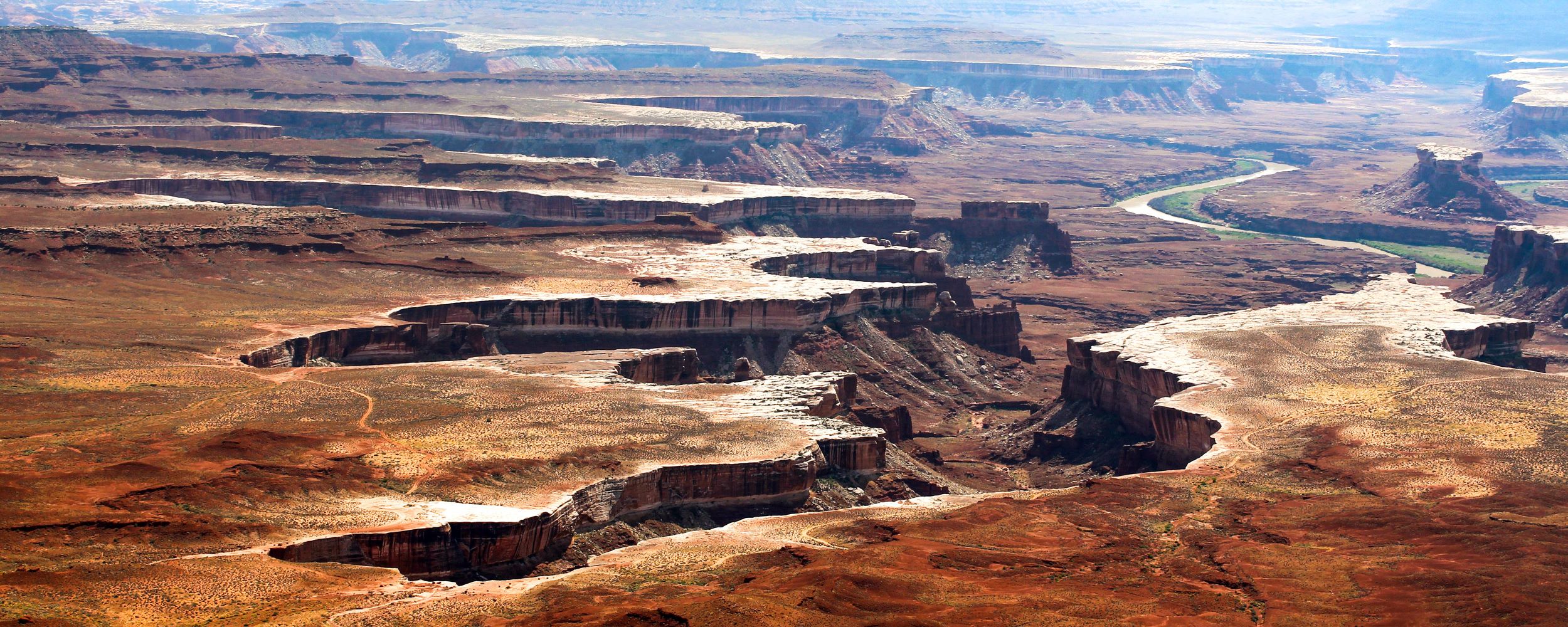
Canyonlands National Park
Canyonlands National Park, located in southeastern Utah, is a vast and rugged landscape characterized by its dramatic canyons, mesas, and buttes carved by the Colorado River and its tributaries. Established as a national park in 1964, it spans over 337,598 acres, offering visitors a spectacular display of natural beauty and geological wonder. The park is divided into four districts: Island in the Sky, The Needles, The Maze, and the rivers themselves, each offering a unique experience and perspective on the park's diverse landscape.
The geological history of Canyonlands is a testament to the power of water and time. Over millions of years, the Colorado River and its tributaries have carved deep canyons into the layered sedimentary rock, creating the park's dramatic and varied landscape. The rock layers exposed in the park range in age from 300 million to 500 million years old and reveal a history of different environments, from seas to deserts to floodplains. This visible stratigraphy provides a vivid geological record of the Earth's past.
The climate in Canyonlands is arid, with hot summers, cold winters, and minimal precipitation. Summer temperatures often exceed 100 degrees Fahrenheit, making early morning and late evening the best times for exploration. Winter can bring cold temperatures and snow, particularly in the higher elevations of the Island in the Sky district. The region's low annual precipitation and high evaporation rates contribute to its desert-like conditions, shaping the park's ecosystems and biodiversity.
The diverse landscapes of Canyonlands support a variety of plant and animal life adapted to its desert environment. Vegetation in the park is primarily composed of hardy desert plants like sagebrush, juniper, and pinyon pine, with cacti and wildflowers adding splashes of color in the spring and summer. The park's fauna includes desert-adapted species such as mule deer, coyotes, and bighorn sheep, as well as a variety of bird species, reptiles, and small mammals.
Island in the Sky, the most accessible district of the park, offers panoramic views of the surrounding canyons and the Colorado River. It features a scenic drive along the mesa top with several overlooks and short hikes, including the popular Mesa Arch Trail, which leads to a stunning natural arch perched on the edge of a cliff.
The Needles district, named for its colorful spires of Cedar Mesa Sandstone, offers a more backcountry experience with extensive hiking trails and four-wheel-drive roads. The district's trails, such as the Chesler Park Loop and the Joint Trail, lead through a landscape of rock formations, canyons, and arches, offering a more immersive exploration of the park's unique geology.
The Maze district, the most remote and challenging area of the park, is a labyrinth of canyons and rock formations. This area is best suited for experienced backcountry adventurers equipped for self-sufficiency and navigation. The Maze offers an opportunity for solitude and a wilderness experience in one of the most remote areas in the United States.
The rivers themselves, primarily the Colorado and Green Rivers, provide a different perspective on the park. River trips, ranging from day trips to multi-week adventures, offer a unique way to experience the park's canyons and scenery. Rafting or kayaking through these rivers reveals a landscape accessible only by water, with opportunities for side hikes and camping along the riverbanks.
Canyonlands' human history is rich, with evidence of ancient Indigenous peoples, such as the Ancestral Puebloans and the Fremont Culture, who left behind rock art and ruins. The park's more recent history includes the activities of ranchers, miners, and explorers, all of whom have left their mark on the landscape.
In conclusion, Canyonlands National Park offers a diverse and spectacular landscape that captures the essence of the American Southwest's rugged beauty. With its deep canyons, towering mesas, and vast expanses of wilderness, the park provides a range of opportunities for exploration, adventure, and solitude. Whether hiking its trails, navigating its rivers, or simply taking in the breathtaking views, Canyonlands is a place of awe and wonder, a testament to the natural forces that shape our world.